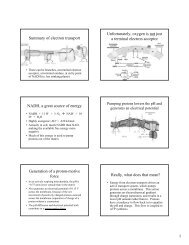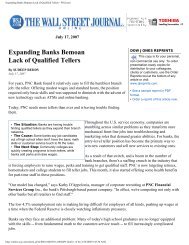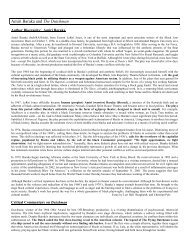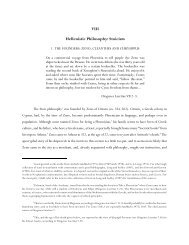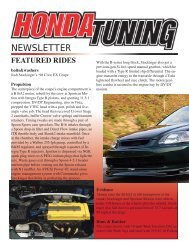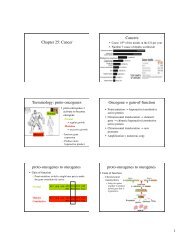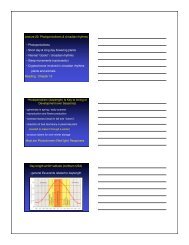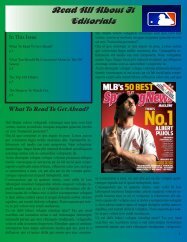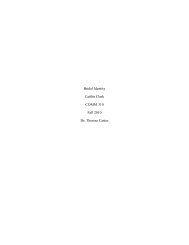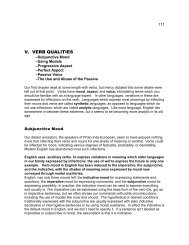Introduction talk (PDF) - UW-Parkside: Help for Personal Homepages
Introduction talk (PDF) - UW-Parkside: Help for Personal Homepages
Introduction talk (PDF) - UW-Parkside: Help for Personal Homepages
You also want an ePaper? Increase the reach of your titles
YUMPU automatically turns print PDFs into web optimized ePapers that Google loves.
Graduate Seminar, Bios 731<br />
Overview of Different Talks/Seminars<br />
- Suggested Formats <strong>for</strong>:<br />
1. 5 minute “Chalk Talk”<br />
2. 20 min. Journal Club<br />
3. 45 min. Research Seminar<br />
- Some Do’s & Don’ts<br />
General Things To Do For ALL Talks<br />
1. Determine the Goal of the Talk<br />
2. Know length and <strong>for</strong>mat (and stick to it)<br />
3. Know the audience (general or specialized?)<br />
4. Make sure your presentation method (chalk <strong>talk</strong>,<br />
powerpoint, overhead, etc…) works with equipment<br />
5. Have backup plan in case of technical problem<br />
(copy on CD/flash drive, prepared overheads, etc…)<br />
In Other Words - Be Prepared!<br />
Organization of 5 Minute Chalk Talk<br />
- A 5 minute <strong>talk</strong> with No prepared figures or handouts!<br />
- Emphasize the “big picture” and key goals.<br />
1 minute - Goals and “big picture”<br />
2 minutes - Background and hypothesis<br />
2 minutes - Your experiments and predicted outcomes<br />
- Simple drawn pictures help (picture = thousand words)<br />
(don’t count on colored chalk, but could help)<br />
- Emphasize why you are personally interested<br />
1
Organization of 20 Minute Journal Club Talk<br />
Prepare and Practice a 18 minute <strong>talk</strong> with Powerpoint<br />
- Select paper - within past two years relevant to topic<br />
- Provide instructor with copy of paper week of Sept. 17<br />
- General Organization:<br />
4 - 5 minutes - Purpose and background to article<br />
5 - 8 minutes - Cover key data (show figures)<br />
- fully explain experiments, controls and key data<br />
5 - 7 minutes - Conclusions, impact and concerns of paper<br />
- Be Critical - Don’t accept just because “in print”<br />
Research Seminar Organization:<br />
• PREPARE and PRACTICE a 45 minute powerpoint <strong>talk</strong>!<br />
• Outline <strong>talk</strong>:<br />
I <strong>Introduction</strong>, ~15 min<br />
- Go from “Big Picture” to the detail of your thesis project<br />
- This is the hook to get your audience interested<br />
II Present a clearly stated hypothesis and how you will test it<br />
~1 - 5 min<br />
III Experiments and Results, ~15 - 20 min<br />
IV Conclusion, ~10 min<br />
- Go from your “detailed” results to how it impacts the<br />
“Big Picture” (opposite of introduction)<br />
- Acknowledgements (thank people who have supported you<br />
and provide you with reagents)<br />
I - <strong>Introduction</strong>, ~10 - 15 min:<br />
1) Overall biological question(s) - “Big picture”<br />
- Emphasize what is interesting about this project<br />
2) Provide necessary background in<strong>for</strong>mation to the project<br />
- Build a story moving from the broad topic of general<br />
interest to your specific thesis project<br />
3) Describe the experimental system and advantages<br />
and disadvantages to it versus others systems<br />
- organism, gene/RNA/protein<br />
- experimental concepts<br />
2
II - Clearly Stated Hypothesis, ~1 - 5 min:<br />
- Present a clear & testable hypothesis that<br />
logically links your background/introduction<br />
and the experiments you will conduct.<br />
Example:<br />
1) To genetically identify and isolate the chloroplast<br />
5’ - 3’ exonuclease.<br />
2) Test to see if this nuclease degrades petD mRNA by<br />
obtaining & studying a 5’ to 3’ exonribuclease mutant<br />
III Experiments and Results, 15 - 20 min:<br />
1) Describe the experimental methods and reagents<br />
- Provide enough detail so the audience can<br />
understand the technique and interpret the data<br />
- Diagram the DNA/RNA/protein/etc. being studied<br />
2) Show the data (graphs, gels, sequence etc.)<br />
- Keep figures complete but not cluttered<br />
- Use diagrams when possible<br />
3) Describe experiments/results in the most logical order<br />
(not always the chronological order)<br />
- “Build” a logical story<br />
- Be a “hypothesis” driven scientist<br />
IV Conclusions, ~5 - 10 min:<br />
1) Summarize key findings from results<br />
- don’t just review the data<br />
- instead summarize what it means to you<br />
2) Conclude how these findings correspond to the<br />
Experimental Goals (relate to introduction)<br />
- Build models that can be further tested<br />
3) Acknowledgements, give credit to people who help you<br />
- do the experiments<br />
- you have collaborated with<br />
- provided you with reagents (clones, antibodies,<br />
programs, etc.)<br />
3
Seminar “To Do” List:<br />
1) One Concept per slide<br />
Keep each slide simple and clear<br />
2) Have <strong>talk</strong> ready 1 - 2 days ahead of time, in case a<br />
computer or personal emergency occurs.<br />
3) Practice, practice, practice <strong>talk</strong>. Best to give a practice<br />
<strong>talk</strong> to lab members (kind audience)<br />
4) Show 10 minutes early to “up load <strong>talk</strong>” and prepare<br />
yourself (drink of water, collect thoughts, etc…)<br />
5) Stay within 45 min time. End on time, even if it means<br />
skipping a slide or two of data. Always show<br />
summary and acknowledgement slides.<br />
Slide Layout / Organization<br />
Title:<br />
Layout:<br />
Clear, Short, and Descriptive<br />
Simple and logical with one<br />
main idea per slide<br />
Figures / data: Well labeled and in logical<br />
order.<br />
Conclusions:<br />
Either write or simply state this<br />
as a transition to next slide.<br />
RNA and Protein Analyses of Mutants<br />
WT<br />
LS2<br />
LS2sup<br />
3 5 8 10 13<br />
RNA<br />
petD<br />
psbA<br />
SU IV<br />
Protein<br />
ATPase-β<br />
WT<br />
5% 25% 100%<br />
LS2<br />
LS2sup<br />
3 5 8 10 13<br />
FUD6<br />
4
Use Large Fonts with High Contrast to Background:<br />
36 font<br />
28 font<br />
24 font<br />
22 font<br />
20 font<br />
16 font<br />
12 font<br />
36 font<br />
28 font<br />
24 font<br />
22 font<br />
20 font<br />
16 font<br />
12 font<br />
Keep the text SIMPLE and SHORT:<br />
36 font<br />
28 font<br />
24 font<br />
22 font<br />
20 font<br />
16 font<br />
12 font<br />
Conclusion: The regulatory elements within the petD mRNA<br />
Are important <strong>for</strong> stabilizing the messenger RNA and <strong>for</strong><br />
Activating translation in the chloroplasts of the single-celled<br />
Alga Chlamydomonas reinhardtii. These elements are essential<br />
And are there<strong>for</strong>e necessary <strong>for</strong> photosynthesis, the process<br />
By which plant cells synthesize carbohydrates in the chloroplast<br />
Organelles.<br />
Selecting Font Styles<br />
Key - Select one, common & easy to read font<br />
- Be consistent<br />
Examples (all in 30 point font size)<br />
Helvetica (sans serif)<br />
Comic Sans MS (sans serif)<br />
Geneva (sans serif)<br />
Times<br />
Times New Roman<br />
Courier<br />
DNA or Protein Sequence Data should not be an<br />
Eye-Exam <strong>for</strong> Audience<br />
Tatgtaaacattctatttta<br />
atacaataaAtaaatttgttg<br />
Aactgccactgacgtcccgtc<br />
Aatacatttgtaagataaaattat<br />
Gtccgttgacggtgactgcagggca<br />
tatattttaaacaataaatcccg<br />
atatttatataaaatttgtta<br />
cccctgcaggattatattt<br />
5
If Audience Can’t Read it, Change it or Don’t Show It<br />
tatgtaaacattctattttaatacaataaataaatttgttggcaggcaactgccactgacgtcccgtcaggggaagggga 80<br />
atacatttgtaagataaaattatgttatttatttaaacaaccgtccgttgacggtgactgcagggcagtccccttcccct<br />
aggggacgtcctaatataaatatattttaaacaataaatcccgcacaaaatatataaatatataatatatattaaaaatt 160<br />
tcccctgcaggattatatttatataaaatttgttatttagggcgtgttttatatatttatatattatatataatttttaa<br />
mRNA start (5' end) RT-1 Primer site<br />
Tttagcatgtaaacattagaaatacagcataattggagtaaaagaaaaatattaaacttttacattgaaaagtttatggc 240<br />
aaatcgtacatttgtaatctttatgtcgtattaacctcattttctttttataatttgaaaatgtaacttttcaaataccg<br />
gttttggctttataaaataaaaaacttttcggaacggctaaaccatatttattatcattaaaatttatttgcccgaaggg 320<br />
caaaaccgaaatattttattttttgaaaagccttgccgatttggtataaataatagtaattttaaataaacgggcttccc<br />
gacgtatccgaaatagaacaaatgccaaaatctactaaattagattaaaatagttttaaaaatggatagatttaaataaa 400<br />
ctgcataggctttatcttgtttacggttttagatgatttaatctaattttatcaaaatttttacctatctaaatttattt<br />
aaacagaagtaaaatgtaattctgtccctttttacagggtggtatctctaaaaaccagggcttgcccaatcaacaattta 480<br />
tttgtcttcattttacattaagacagggaaaaatgtcccaccatagagatttttggtcccgaacgggttagttgttaaat<br />
Translation start site<br />
aagcttatttagttttattgaaaattaacggataaataaatatg tcagttactaaaaaacctgatttaagcgatccagtt 560<br />
ttcgaataaatcaaaataacttttaattgcctatttatttatacagtcaatgattttttggactaaattcgctaggtcaa<br />
RT-2 Primer site<br />
ttaaaagcaaaattagctaaaggtatgggtcacaacacttacggtgaacctgcttggcctaacgatttattatacatgtt 640<br />
aattttcgttttaatcgatttccatacccagtgttgtgaatgccacttggacgaaccggattgctaaataatatgtacaa<br />
ccctgttgttattttaggtacatttgcatgtgttattggtttatctgttttagacccagctgctatgggtgagccagcaa 720<br />
gggacaacaataaaatccatgtaaacgtacacaataaccaaatagacaaaatctgggtcgacgatacccactcggtcgtt<br />
acccatttgctactccacttgaaattttaccagaatggtatttctaccctgtattccaaattttacgtgtagttccaaac 800<br />
tgggtaaacgatgaggtgaactttaaaatggtcttaccataaagatgggacataaggtttaaaatgcacatcaaggtttg<br />
aaacttctaggtgtattattaatggcagcagtacctgcaggccttatcacggtaccgttcattgaaagtattaacaaatt 880<br />
tttgaagatccacataataattaccgtcgtcatggacgtccggaatagtgccatggcaagtaactttcataattgtttaa<br />
ccaaaacccataccgtcgtccaatcgctactatcttattccttttaggaactttagttgctgtttggttaggtattggtt 960<br />
ggttttgggtatggcagcaggttagcgatgatagaataaggaaaatccttgaaatcaacgacaaaccaatccataaccaa<br />
Translation stop site<br />
caacattccctattgatatttctttaactttaggtttattctaatctaaaattttaaatttccctctagggttgcaatac1040<br />
gttgtaagggataactataaagaaattgaaatccaaataagattagattttaaaatttaaagggagatcccaacgttatg<br />
mRNA stop (3 ’ end)<br />
gatttgcaacctgaagggggaaaactgagttctctcatttttttaagaactccatc 1096<br />
ctaaacgttggacttcccccttttgactcaagagagtaaaaaaattcttgaggtag<br />
Color Selection:<br />
• Use them wisely to highlight key aspects<br />
• Use colors that contrast with background<br />
• Too much color can be a problem<br />
C. reinhardtii, P17<br />
I<br />
II<br />
III<br />
AUG<br />
C. eugametos<br />
? II III<br />
AUG<br />
C. reinhardtii<br />
C. eugametos<br />
I<br />
TTAGCATG<br />
?<br />
II<br />
CTAAATTA-GATTAAAA<br />
CTAAATTctGAaaAA<br />
III<br />
TTTAAAGCTTATTT<br />
TTTAAAGCTacT<br />
Acknowledgements: Current and Past Students<br />
Undergraduate Students:<br />
Theresa Dailey<br />
Michael Fischer<br />
Ashley Gehrand<br />
José Henriquez<br />
Jamie Jaskolski<br />
Nathan Jeanson<br />
Lynn Kramzar<br />
Jennifer Lavender<br />
Ed Manteufel<br />
Dane Popovski<br />
Kate Schassberger<br />
Jacob Tatay<br />
Graduate Students:<br />
Brian Erickson<br />
Michael Fischer<br />
Ashley Gehrand<br />
Lynn Kramzar<br />
Toby Mueller<br />
Jacob Tatay<br />
Kyle Upchurch<br />
6
Acknowledgements: Collaborators and Funding<br />
Cornell University <strong>UW</strong>-Milwaukee<br />
David Stern<br />
Heather Owen<br />
Rob Drager<br />
Donna Esposito<br />
Shinya Murakami<br />
Linda Rymarquis<br />
Funding Sources<br />
NSF-CCLI<br />
USDA-NRI<br />
<strong>UW</strong>-<strong>Parkside</strong>, CRCA<br />
<strong>UW</strong>-<strong>Parkside</strong>, BRI<br />
7




